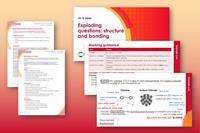Using this technique, learners can approach extended-response exam questions with more confidence
This resource accompanies the article Improve literacy in science students in Education in Chemistry.
Learning objectives
1 Recall your prior learning on bonding, structure, the properties of matter and changes of state.
2 Develop a technique to tackle extended-response exam questions and improve your answers.
Introduction
If learners do not understand the language used in questions, they may struggle to present their answers clearly, lose marks for contradictions, use the wrong key words or miss key information.
In the exploding question technique, learners annotate the question, or associated diagrams, with important facts relevant to the topic. This guides them to better answers to extended-response exam questions.
Modelling the technique for learners will enable them to use it independently and by using good example questions they can benefit from their peers’ knowledge too.

This resource is part of our Teaching science skills series, bringing together strategies and classroom activities to help your learners develop essential scientific skills, from practical planning to ethics and more.
How to use the resource
Use the PowerPoint slides to introduce example one, a real past-paper question. Slide four shows how to annotate the question; command words/key instructions are boxed and key words within the question are underlined.
Slide five explodes the question, identifying key information. The blue text describes the bonding and structure and the red text provides the explanation prompted by the question.
Then, ask your learners to write their answers independently. By ticking or highlighting when a point is included they can ensure they have covered all necessary information, hopefully maximising their marks. Share the marking guidance (slide seven) with learners so they can check how successful they have been.
Example two provides another, similar question to give learners the opportunity to practise the technique. Ask them to work on their own first, then discuss their exploded question in pairs or small groups before writing an answer.
Differentiation and support
You can use the questions below to help explode the question in the first example or to support those learners who need it with the second example.
Alternatively, you can support learners with writing answers to extended-response questions using structure strips, find more information and template. This may be useful for learners who need more support with the writing part of the task.
Example one support questions
Chlorine
- Is chlorine a metal or a non-metal?
- What type of bonding does chlorine have?
- Is it a simple covalent or a giant covalent molecule?
- What forces are found between chlorine molecules?
- Are these forces strong or weak?
- Is a little or a lot of energy needed to overcome these forces?
- So, does chlorine have a low or high melting point and boiling point?
Sodium chloride
- Is chlorine a metal or a non-metal?
- Is sodium a metal or a non-metal?
- What type of bonding does sodium chloride have?
- What do you call this type of structure?
- What forces are found between the positive sodium and negative chloride ions?
- Are these forces strong or weak?
- Is a little or a lot of energy needed to overcome these forces?
- So, does sodium chloride have a low or high melting point and boiling point?
Example two support questions
Carbon dioxide
- Is carbon a metal or a non-metal?
- Is oxygen a metal or a non-metal?
- What type of bonding does carbon dioxide have?
- Is it a simple covalent or a giant covalent molecule?
- What forces are found between the carbon dioxide molecules?
- Are these forces strong or weak?
- Is a little or a lot of energy needed to overcome these forces?
- So, does carbon dioxide have a low or high melting point and boiling point?
Diamond
- Name the element diamond consists of?
- Is this element a metal or a non-metal?
- What type of bonding does diamond have?
- Is it a simple covalent or a giant covalent molecule?
- Does it have forces or bonds between atoms?
- Are these strong or weak?
- Is a little or a lot of energy needed to overcome them?
- So, does diamond have a low or high melting point and boiling point?
Give learners who have confidently grasped the technique another extended-response question to try independently.
Downloads
Exploding questions: structure and bonding - slides
Presentation | PowerPoint, Size 0.27 mbExploding questions: structure and bonding - slides
Presentation | PDF, Size 0.47 mbExploding questions: structure and bonding - teacher notes
Handout | PDF, Size 0.17 mbExploding questions: structure and bonding - teacher notes
Editable handout | Word, Size 0.43 mb
































No comments yet